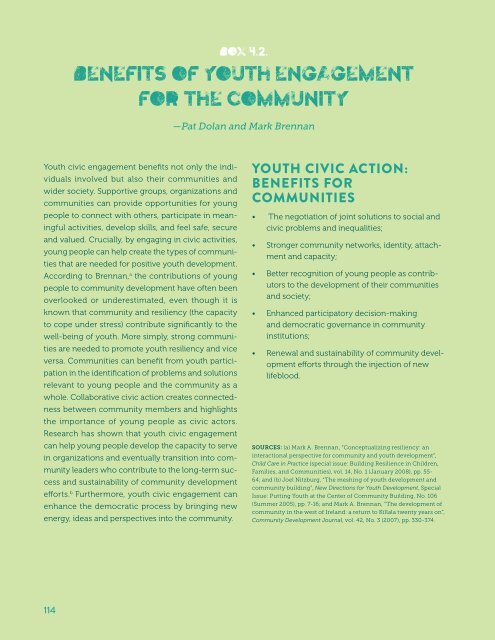YOUTH CIVIC
JieguI2U
JieguI2U
You also want an ePaper? Increase the reach of your titles
YUMPU automatically turns print PDFs into web optimized ePapers that Google loves.
BOX 4.2.<br />
BENEFITS OF <strong>YOUTH</strong> ENGAGEMENT<br />
FOR THE COMMUNITY<br />
—Pat Dolan and Mark Brennan<br />
Youth civic engagement benefits not only the individuals<br />
involved but also their communities and<br />
wider society. Supportive groups, organizations and<br />
communities can provide opportunities for young<br />
people to connect with others, participate in meaningful<br />
activities, develop skills, and feel safe, secure<br />
and valued. Crucially, by engaging in civic activities,<br />
young people can help create the types of communities<br />
that are needed for positive youth development.<br />
According to Brennan, a the contributions of young<br />
people to community development have often been<br />
overlooked or underestimated, even though it is<br />
known that community and resiliency (the capacity<br />
to cope under stress) contribute significantly to the<br />
well-being of youth. More simply, strong communities<br />
are needed to promote youth resiliency and vice<br />
versa. Communities can benefit from youth participation<br />
in the identification of problems and solutions<br />
relevant to young people and the community as a<br />
whole. Collaborative civic action creates connectedness<br />
between community members and highlights<br />
the importance of young people as civic actors.<br />
Research has shown that youth civic engagement<br />
can help young people develop the capacity to serve<br />
in organizations and eventually transition into community<br />
leaders who contribute to the long-term success<br />
and sustainability of community development<br />
efforts. b Furthermore, youth civic engagement can<br />
enhance the democratic process by bringing new<br />
energy, ideas and perspectives into the community.<br />
<strong>YOUTH</strong> <strong>CIVIC</strong> ACTION:<br />
BENEFITS FOR<br />
COMMUNITIES<br />
• The negotiation of joint solutions to social and<br />
civic problems and inequalities;<br />
• Stronger community networks, identity, attachment<br />
and capacity;<br />
• Better recognition of young people as contributors<br />
to the development of their communities<br />
and society;<br />
• Enhanced participatory decision-making<br />
and democratic governance in community<br />
institutions;<br />
• Renewal and sustainability of community development<br />
efforts through the injection of new<br />
lifeblood.<br />
SOURCES: (a) Mark A. Brennan, “Conceptualizing resiliency: an<br />
interactional perspective for community and youth development”,<br />
Child Care in Practice (special issue: Building Resilience in Children,<br />
Families, and Communities), vol. 14, No. 1 (January 2008), pp. 55-<br />
64; and (b) Joel Nitzburg, “The meshing of youth development and<br />
community building”, New Directions for Youth Development, Special<br />
Issue: Putting Youth at the Center of Community Building, No. 106<br />
(Summer 2005), pp. 7-16; and Mark A. Brennan, “The development of<br />
community in the west of Ireland: a return to Killala twenty years on”,<br />
Community Development Journal, vol. 42, No. 3 (2007), pp. 330-374.<br />
114


